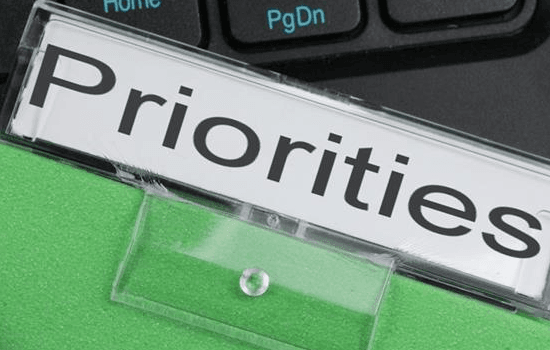Improve your concentration at work: 10 tips to use

Focusing at work is a challenge for professionals, constantly bombarded by emails, notifications, and colleagues' requests. These interruptions harm their attention and productivity. However, there are several tips and best practices to improve concentration and thus increase efficiency.
Setting Priorities

To start your day productively, it's crucial to determine the most important tasks and organize them by priority. Here's a detailed guide to help you accomplish this effectively:
1. Make a Task List
Every morning, take a few minutes to list all the tasks you need to accomplish. Include both major projects and small daily tasks.
2. Assess Importance and Urgency
Use the Eisenhower Matrix to assess each task based on its importance and urgency:
Important and Urgent : These tasks require immediate attention and should be prioritized. They often relate to close deadlines or critical situations.
Important but Not Urgent : These are strategic tasks that contribute to your long-term goals. Schedule them after urgent tasks but don't neglect them.
Urgent but Not Important : These tasks may be interruptions or requests from others. If possible, delegate them.
Not Urgent and Not Important : These tasks can often be eliminated or postponed.
3. Set Clear Objectives
For each important task, clearly define what you aim to achieve. Having specific goals makes tasks more manageable and helps you stay focused.
4. Estimate Required Time
Estimate the time needed for each task. This will help you plan your day realistically and avoid overloading your schedule.
5. Block Time Slots
Block specific time slots for priority tasks in your calendar. Make sure to devote your most productive moments of the day (e.g., mornings for most people) to these tasks.
6. Use the Rule of 3 Main Tasks
Identify the three most important tasks you need to accomplish by the end of the day. Focus on these tasks to ensure you make significant progress every day.
7. Avoid Multitasking
Focus on one task at a time. Multitasking can reduce your efficiency and the quality of your work. Complete one task before moving on to the next.
8. Reevaluate and Adjust
As you progress through the day, reassess your priorities. If urgent or important tasks arise, adjust your schedule accordingly.
9. Reflect at the End of the Day
At the end of each day, take a few minutes to assess what you've accomplished. Note what worked well and what could be improved. Use this reflection to plan for the next day.
By following these steps, you can ensure that your time and energy are devoted to tasks that have the most impact, thereby improving your productivity and efficiency at work.
Use time management tools

To stay organized and productive, it's essential to use time management tools that help you visualize and track your tasks. Here is a detailed guide on the different types of tools available and how to use them effectively:
1. Traditional Planners
Paper planners remain a popular tool for scheduling days. They provide a weekly or monthly overview, allowing you to note appointments, deadlines, and important tasks.
- Advantages :
- Ease of use.
- No need for technology.
- Visual and tactile, which can aid in memorization.
- Usage :
- Note appointments and deadlines.
- Plan daily tasks.
- Use color codes to differentiate types of tasks.
2. Task Management Apps
Digital applications like Trello, Asana, Todoist, and Microsoft To Do are ideal for managing and visualizing your tasks. They offer advanced features such as list creation, project management, and collaboration with colleagues.
- Trello :
- Uses boards, lists, and cards to organize tasks.
- Allows visualization of workflow and assignment of tasks to team members.
- Integrates with other tools (Google Drive, Slack, etc.).
- Asana :
- Great for complex projects with many subtasks.
- List, board, or calendar view to plan and track progress.
- Advanced collaboration features, including comments and tracking.
- Todoist :
- Simple and effective task list with priority options.
- Integrates with tools like Gmail and Google Calendar.
- Reminder and recurring scheduling features.
3. Handwritten Lists
Handwritten lists are a simple and accessible method for tracking your daily tasks. They clarify priorities and provide a tangible view of what needs to be done.
- Advantages :
- Simplicity and absence of digital distractions.
- Satisfying to check off tasks once completed.
- Flexibility to customize according to your needs.
- Usage :
- Create a task list each morning or the night before.
- Prioritize tasks.
- Use highlighters or colored pens to differentiate types of tasks.
4. Digital Calendars
Digital calendars like Google Calendar, Outlook Calendar, and Apple Calendar allow you to schedule appointments, events, and tasks with automatic reminders.
- Google Calendar :
- Syncs across all devices.
- Creation of multiple calendars for different aspects of life (work, personal, etc.).
- Reminder and notification feature to ensure nothing is forgotten.
- Outlook Calendar :
- Integrated with Outlook emails and tasks.
- Easy calendar sharing with colleagues.
- Meeting scheduling and room booking features.
- Apple Calendar :
- Syncs across all Apple devices.
- Integration with Siri to add events through voice command.
- Clear and intuitive calendar view.
5. Mind Mapping Tools
Mind mapping tools like MindMeister or XMind allow you to visualize and organize ideas and tasks in a creative and non-linear manner.
- MindMeister :
- Online mind mapping with collaboration options.
- Add tasks, deadlines, and priorities directly onto the map.
- Brainstorming and project planning features.
- XMind :
- Comprehensive mind mapping with flowchart and fishbone diagram options.
- Add notes, images, and links for information-rich mind maps.
- Export to various formats (PDF, Word, etc.) for sharing.
Establish a realistic schedule

Organizing your day into time blocks dedicated to specific tasks, while scheduling regular breaks, is an effective strategy to improve concentration and avoid mental fatigue. Here’s how to implement this method in detail:
1. Planning Time Blocks
a. Define Main Tasks
- Identify important tasks : Note down priority tasks and estimate the time required for each.
- Group similar tasks : Combine similar tasks to complete them more efficiently (e.g., answering emails or meetings).
b. Allocate Specific Time Slots
- Morning for complex task : Reserve the first hours of the day for tasks that require intense concentration. The mind is often fresher and more alert in the morning.
- Afternoon for meetings and routine tasks : Schedule less demanding tasks or meetings in the afternoon.
2. Time Management Methods
a. Pomodoro Technique
- Principle: Work for 25 minutes, followed by a 5-minute break.
- Cycle: After four cycles, take a longer break of 15-30 minutes.
- Advantages: Promotes intense concentration during work sessions and reduces the risk of mental fatigue
b. Time Blocking
- Principle: Divide the day into time blocks for each task or group of tasks.
- Application: For example, 9 AM to 11 AM for report writing, 11 AM to 12 PM for meetings, etc.
- Advantages: Clarifies priorities and ensures that time is allocated for each essential task.
3. Incorporate Regular Breaks
a. Short Breaks
- Frequency: Take a 5 to 10-minute break every 60 to 90 minutes.
- Activities: Walk, stretch, drink water, or simply relax your eyes by looking into the distance.
b. Long Breaks
- Frequency: A longer break of 30 to 60 minutes, ideally around lunchtime.
- Activities: Eat a healthy meal, take a walk outside, or practice relaxation techniques.
4. Manage Interruptions
a. Create an Optimal Work Environmen
- Space: Work in a quiet and orderly environment.
- Signs: Use visual signals (e.g., a "Do Not Disturb" sign) to inform others that you are focused.
b. Technology
- Notifications: Turn off unnecessary notifications on your computer and phone during work blocks.
- Focus Applications: Use apps like Focus@Will or Freedom to limit digital distractions.
5. Adapt and Adjust
a. Daily Review
- Evaluation: At the end of the day, assess what has been accomplished and adjust the time blocks for the next day based on remaining priorities.
b. Flexibility
- Adaptation: Be flexible and adjust your schedule according to unforeseen events and emergencies while maintaining an overall structure.
Adopt the Pomodoro method

The Pomodoro Technique is a simple and effective time management method designed to improve concentration and productivity while preventing mental fatigue. Here’s a detailed guide on how to implement this technique:
1. Origin and Principle of the Pomodoro Technique
- Origin: Created by Francesco Cirillo in the late 1980s, the name "Pomodoro" (which means "tomato" in Italian) comes from the tomato-shaped kitchen timer Cirillo used.
- Principle: Divide work into time intervals, called "Pomodori" (plural of Pomodoro), each lasting 25 minutes, separated by short breaks.
2. Steps to Use the Pomodoro Technique
a. Preparation
- Task List: Start by writing a list of tasks you need to accomplish.
- Equipment: Use a timer, whether physical (like a kitchen timer) or a timer app on your smartphone or computer.
b. Execution
- Set the Task: Choose a task from your list to focus on for the next Pomodoro.
- Start the Timer: Set the timer for 25 minutes and begin working on the chosen task.
- Work Without Interruption: Work in a focused and uninterrupted manner until the timer rings.
- Short Break: Take a 5-minute break to relax. During this break, stand up, stretch, drink water, or take a short walk.
- Repeat: Repeat the above steps for a total of four Pomodori.
c. Long Break
- After Four Pomodori: Take a longer break of 15 to 30 minutes after completing four Pomodori cycles.
- Activities During Long Break: Engage in relaxing activities that allow you to recharge, such as eating a snack, taking a short walk, or practicing breathing exercises.
3. Benefits of the Pomodoro Technique
a. Improved Concentration
- Intense Focus: By working in short, well-defined intervals, you can maintain intense concentration without feeling overwhelmed.
- Limitation of Distractions: The structure of the technique helps minimize distractions since you know a break is coming soon.
b. Time Management
- Clarity on Time: You become more aware of the time you spend on each task, which improves time management and planning.
- Productivity Evaluation: Tracking the number of Pomodori needed to complete a task gives you a clear measure of your productivity.
c. Prevention of Burnout
- Regular Breaks: Regular breaks prevent mental fatigue and help maintain energy throughout the day.
- Recovery and Rest: Long breaks allow for complete recovery, thus avoiding burnout.
4. Applications and Tools for the Pomodoro Technique
a. Physical Timers
- Kitchen Timer: Use a traditional kitchen timer, ideal for technological disconnection.
b. Mobile and Desktop Apps
- Focus Booster: A simple app with a Pomodoro timer and productivity reports.
- Pomodone: Integration with task management tools like Trello and Asana, offering advanced Pomodoro management.
- Toggl: A time-tracking tool that can be used to set up Pomodoro sessions.
c. Browser Extensions
- Marinara Timer: A Chrome extension offering customizable Pomodoro timers.
- Tomato Timer: A simple web interface to manage your Pomodori directly from your browser.
5. Tips for Optimizing the Use of the Pomodoro Technique
a. Managing Interruptions
- Work Environment: Create a distraction-free workspace to maximize your focus.
- Note Interruptions: If interrupted, note the distraction and quickly return to your task.
b. Flexibility and Adaptation
- Adjust Durations: If 25 minutes doesn’t work for you, adjust the lengths of Pomodori and breaks according to what suits you best.
- Listen to Your Body: Pay attention to your needs and adjust breaks accordingly.
Anticipate the unexpected

Integrating buffer time into your schedule is an effective strategy for managing unexpected events and emergencies without disrupting your overall timetable. Here’s how to implement this approach in detail:
1. Understanding the Importance of Buffer Time
a. Nature of Unexpected Events
- Types of Interruptions: Interruptions can include urgent emails, sudden requests from colleagues, technical issues, or unforeseen administrative tasks.
- Frequency: These interruptions are common and unavoidable in almost all work environments.
b. Impact on Productivity
- Disruptions: Unexpected events can disrupt your concentration and workflow, leading to a loss of time and efficiency.
- Stress and Frustration: Failing to allocate time for unexpected events can increase stress and frustration, harming your overall well-being.
2. Integrating Buffer Time into Your Schedule
a. Assessing Needs
- Analyze Past Interruptions: Review your past days to identify the frequency and average duration of unexpected interruptions.
- Estimate: Determine a realistic estimate of the time needed to handle these daily.
b. Allocating Buffer Time Blocks
- Time Slots: Reserve specific periods in your day as buffer time. For example, 15 minutes in the morning and 15 minutes in the afternoon.
- Flexibility: Ensure these periods are flexible enough to be used as needed without disrupting planned tasks.
3. Techniques for Managing Interruptions
a. The 2-Minute Rule
- Principle: If an interruption or new task can be completed in 2 minutes or less, do it immediately.
- Advantages: This rule helps quickly eliminate small tasks, preventing them from piling up and becoming overwhelming.
b. List of Unexpected Tasks
- Interruptions Journal: Keep a journal or list of interruptions and unexpected tasks to better understand and anticipate these events in the future.
- Planning: Add these unexpected tasks to a dedicated list that you review and manage during your buffer time.
4. Organization and Prioritization
a. Prioritize Unexpected Events
- Urgency vs. Importance: Assess each interruption to determine its urgency and importance. Urgent and important tasks should be handled immediately, while others can be scheduled for later.
- Rescheduling Tasks: If an unexpected task takes time, be ready to reorganize your schedule and move less priority tasks to another time.
b. Communication
- Inform Colleagues: Let your colleagues know you have specific periods to handle interruptions to minimize disruptions during high-concentration times.
- Availability: Use visual indicators (like "do not disturb" signs or online statuses) to show when you are available for interruptions.
5. Adapting and Adjusting Your Schedule
a. Daily Review
- Day Evaluation: At the end of each day, evaluate how well unexpected events were managed and whether the buffer times were sufficient.
- Adjustments: Adjust the duration and frequency of buffer times based on your daily experience.
b. Flexibility
- Adaptability: Be flexible and ready to adjust your schedule in real time based on the nature and urgency of interruptions.
- Preparation: Have alternatives and backup plans for scheduled tasks in case of major interruptions.
Do a daily review

At the end of each workday, taking the time to evaluate your accomplishments and prepare your task list for the next day is an essential habit for continuously improving your efficiency and productivity. Here’s a detailed guide on how to implement this practice:
1. Evaluating Accomplishments
a. Reflecting on the Day
- List of Achievements: Spend a few minutes listing what you have accomplished throughout the day. This includes completed tasks, achieved goals, and resolved issues.
- Sense of Accomplishment: Recognizing your achievements can boost your motivation and sense of satisfaction.
b. Analyzing Methods Used
- Effective Techniques: Identify the techniques and strategies that worked well, such as time management methods (e.g., the Pomodoro technique), task organization, or tools used.
- Encountered Obstacles: Note any obstacles and interruptions that disrupted your work, such as distractions, unforeseen emergencies, or time management issues.
2. Identifying Potential Improvements
a. Areas for Improvement
- Ineffective Strategies: Identify strategies that didn’t work well or that could be improved. For instance, if a particular time management technique wasn’t effective, consider an alternative.
- Managing Interruptions: Evaluate how you handled interruptions and unforeseen events. Note techniques that might work better for minimizing these disruptions in the future.
b. Goals for Tomorrow
- Setting New Goals: Based on the day’s evaluation, set clear and specific goals for the next day. Ensure they are realistic and achievable.
- Action Plan: Develop an action plan to address identified areas for improvement. For example, if interruptions were a problem, schedule specific time slots to handle emergencies.
3. Preparing the Task List for the Next Day
a. Task List
- Priority Tasks: Start by listing the most important and urgent tasks to accomplish the next day. Use techniques like the Eisenhower matrix to prioritize these tasks.
- Less Urgent Tasks: Also include less urgent but necessary tasks and schedule them for times when your energy might be lower.
b. Organization and Planning
- Time Blocks: Allocate specific time blocks for each task or group of tasks, ensuring to include buffer time for unexpected events.
- Using Tools: Use task management tools like Trello, Asana, or planners to organize your task list visually and structurally.
c. Scheduling Breaks
- Regular Breaks: Plan regular breaks to prevent mental fatigue and maintain a high level of concentration throughout the day.
- Long Breaks: Include a longer break for lunch or a relaxing activity to recharge your batteries
4. Continuous Review and Adjustment
a. Tracking Progress
- Daily Progress: Track your daily progress by comparing what you planned with what you accomplished.
- Weekly Evaluation: Conduct a more comprehensive weekly evaluation to identify trends and adjust your strategies for the longer term.
b. Flexibility and Adaptability
- Adaptation: Be prepared to adjust your plans and methods based on the results of your daily evaluation. Flexibility is key for effective time and task management.
- Continuous Learning: Consider each day an opportunity to learn. Use the information gathered to constantly refine your time management techniques and improve your productivity.
Eliminate distractions

Identifying and reducing the main sources of distractions is essential to maintain a high level of concentration and productivity. Here’s a detailed guide on how to effectively tackle this task:
1. Analyzing Sources of Distractions
a. Identifying Common Distractions
- Distracting Elements: Identify what most often diverts your attention from your tasks, such as phone notifications, incoming emails, social media, or noisy conversations.
- Moments of Weakness: Note the times of day when you are most likely to be distracted, such as after lunch or late in the day.
b. Impact on Productivity
- Consequences of Distractions: Assess how these distractions affect your work and efficiency. This might include decreased work quality, delayed deadlines, or increased stress.
2. Strategies to Minimize Distractions
a. Managing Notifications
- Selective Deactivation: Turn off non-essential notifications on your phone and computer during focused work periods.
- Using Do Not Disturb Modes: Activate "Do Not Disturb" modes on your devices to block all notifications during specific time slots.
b. Creating a Concentration-Friendly Environment
- Quiet Workspace: Set up a quiet and orderly workspace, away from high-traffic and noisy areas.
- Eliminating Visual Distractions: Reduce visual distractions by keeping unnecessary items out of sight and maintaining a clean, organized workspace.
c. Using Blocking Applications
- Website Blocking Tools: Use tools like Cold Turkey, Freedom, or StayFocusd to block access to unproductive websites during specific periods.
- Browser Extensions: Install browser extensions that limit access to specific sites or alert you when you spend too much time online.
3. Planning Intense Work Sessions
a. Time Management Techniques
- Pomodoro Technique: Use the Pomodoro method to work in defined time intervals, followed by short breaks. This promotes intense concentration while allowing for regular rest periods.
- Time Blocking: Allocate specific time blocks for particular tasks or projects, ensuring minimal distractions during these periods.
b. Communication and Expectation Management
- Communicating with Colleagues: Inform your colleagues about your focused work periods to minimize interruptions during these times.
- Managing Expectations: Set clear expectations with your team regarding your availability and response times to reduce non-urgent interruptions.
4. Self-Evaluation and Continuous Adjustment
a. Daily Reflection
- Self-Evaluation: At the end of each day, reflect on your ability to stay focused and minimize distractions. Identify what worked well and what can be improved.
- Adjusting Strategies: Be ready to adjust your strategies based on the results of your daily evaluation. What works for one person might not work for another, so experiment to find what suits you best.
b. Forming Sustainable Habits
- Consistency: Regularly practice time management techniques and distraction minimization strategies to form lasting habits.
- Patience and Perseverance: Be patient with yourself and persevere even if you encounter difficulties initially. Mastering these skills takes time and practice.
Delegate when possible

Learning to delegate effectively is a valuable skill that helps reduce workload, maximize efficiency, and focus on essential tasks. Here’s a detailed guide on how to delegate strategically:
1. Identifying Tasks to Delegate
a. Analyzing Responsibilities
- Task Evaluation: Review your daily tasks and identify those that do not necessarily require your expertise or direct involvement.
- Delegation Criteria: Look for recurring, time-consuming, or less strategic tasks that could be assigned to other team members.
b. Considering Skills and Resources
- Strengths and Weaknesses: Identify your own strengths and weaknesses as well as those of your team. Delegate tasks that align with the skills and interests of your team members.
- Availability: Ensure that the people you delegate tasks to have the capacity and resources necessary to complete them successfully.
2. Communication and Setting Expectations
a. Clarity of Objectives
- Task Definition: Clearly explain what is expected for each delegated task, including desired outcomes, deadlines, and any relevant instructions.
- Questions and Clarifications: Encourage team members to ask questions and seek clarifications to avoid misunderstandings.
b. Encouraging Initiative
- Autonomy: Provide some freedom and autonomy to those you delegate tasks to. Encourage them to take initiative and propose creative solutions.
- Support and Guidance: Be available to provide support and advice when needed, but avoid micromanaging the process.
3. Monitoring and Feedback
a. Regular Follow-Up
- Progress Checks: Schedule regular check-ins to monitor the progress of delegated tasks. This ensures everything is on track and allows for corrective actions if necessary.
- Adjustments: Be ready to adjust plans and expectations based on changing circumstances or emerging needs.
b. Constructive Feedback
- Recognizing Achievements: Praise and acknowledge team members for their good work and accomplishments.
- Positive and Constructive Feedback: Provide regular feedback, both positive and constructive, to help strengthen skills and improve performance.
4. Developing Skills and Confidence
a. Learning Opportunities
- Ongoing Training: Use delegation as an opportunity to develop the skills and capabilities of your team. Encourage continuous learning and professional growth.
- Rotating Responsibilities: Offer development opportunities by allowing different team members to take on various tasks.
b. Building Confidence
- Empowerment: Give your team members the responsibility to make decisions and manage projects. This boosts their confidence and sense of accomplishment.
- Constructive Feedback: Provide regular and encouraging feedback to help reinforce confidence and competence.
5. Self-Evaluation and Continuous Improvement
a. Reflecting on Outcomes
- Results Evaluation: At the end of each project or defined period, assess the outcomes of your delegation. Identify what worked well and what could be improved.
- Learning from Experience: Use each delegation experience as a learning opportunity to refine your delegation skills.
b. Adjusting Strategies
- Adaptability: Be ready to adjust your delegation strategies based on lessons learned and feedback received. What works for one task or team may require adjustments for other situations.
- Persistence: Be patient and persevere in your delegation efforts. It may take time to master this skill, but the long-term benefits are worth it.
Take care of yourself

Integrating personal well-being into your daily routine is essential for maintaining high productivity and efficiency. Here’s how to take care of your well-being to optimize your organization and performance:
1. Committing to Quality Sleep
a. Sleep Routine
- Regular Schedule: Establish a consistent sleep routine by going to bed and waking up at the same time every day, even on weekends.
- Sleep Environment: Create a conducive sleep environment by keeping your bedroom cool, dark, and quiet.
b. Sleep Quality
- Avoiding Stimulants: Limit caffeine and alcohol intake, especially later in the day, to promote restful sleep.
- Stress Management: Practice relaxation techniques, such as meditation or deep breathing, to calm your mind before bedtime.
2. Adopting a Balanced Diet
a. Balanced Meals
- Nutritious Foods: Prioritize nutrient-rich foods like fruits, vegetables, lean proteins, and whole grains to maintain stable energy levels throughout the day.
- Adequate Hydration: Ensure you stay hydrated by drinking enough water throughout the day.
b. Snack Management
- Healthy Options: Opt for healthy snacks like fresh fruits, nuts, or natural yogurts to avoid energy slumps and cravings between meals.
- Avoiding Excess: Limit the intake of processed foods high in sugar and fat, which can cause blood sugar spikes and energy crashes.
3. Engaging in Regular Physical Activity
a. Incorporating Exercise into Your Routine
- Personal Choice: Choose physical activities you enjoy, such as walking, running, yoga, or swimming, and regularly integrate them into your schedule.
- Small Changes: Find simple ways to add more movement to your day, like taking the stairs instead of the elevator or taking a short walk during breaks.
b. Benefits of Exercise
- Stress Reduction: Regular exercise is an excellent way to reduce stress and anxiety, which can improve your focus and ability to handle work tasks.
- Increased Energy: Physical activity boosts blood circulation and releases endorphins, helping you feel more energetic and alert.
4. Practicing Stress Management and Relaxation
a. Stress Management Techniques
- Meditation and Mindfulness: Dedicate a few minutes each day to meditation or mindfulness to calm your mind and reduce stress.
- Deep Breathing: Practice deep breathing exercises to promote relaxation and mental clarity.
b. Time for Relaxation
- Relaxing Activities: Engage in activities that relax and soothe you, such as reading a book, listening to music, or spending time with loved ones.
- Limiting Overcommitments: Learn to say no to excessive commitments and prioritize your well-being, even when your schedule is busy.
Be flexible and adapt

Even with meticulous planning, it is crucial to recognize the importance of flexibility and adaptability in effective work management. Here’s why maintaining these qualities is essential and some strategies to cultivate them:
1. Understanding the Importance of Flexibility
a. Responsiveness to Change
- Dynamic Nature of Work: The professional world is unpredictable and subject to constant changes, such as last-minute emergencies, priority adjustments, or unforeseen events.
- Adaptability: Being flexible allows for quick adaptation to these changes without compromising work quality or goal achievement.
b. Resilience in Facing Challenges
- Obstacle Management: Flexibility enables constructive handling of obstacles and challenges by seeking alternative solutions and adjusting work plans as necessary.
- Stress Reduction: Being flexible helps reduce stress and anxiety related to unforeseen changes, as it allows for maintaining a sense of control and confidence.
2. Cultivating Adaptability in Your Work Approach
a. Acceptance of Uncertainty
- Open Attitude: Adopt an open and positive attitude towards uncertainty and change, recognizing that they are integral to any professional environment.
- Perspective Shift: View changes as opportunities for learning and growth rather than obstacles.
b. Mental Agility
- Critical Thinking: Develop your ability to think critically and quickly evaluate new information or changing situations to make informed decisions.
- Cognitive Flexibility: Be willing to challenge your assumptions and modify your strategies based on new data or changing requirements.
3. Strategies to Maintain Flexibility
a. Reactive Planning
- Adjustable Plans: Create flexible plans that can be easily adjusted in response to changing circumstances. Include buffer times in your schedule to handle unforeseen events.
- Open Communication: Maintain regular contact with team members to ensure everyone is informed about changes and necessary adjustments.
b. Agile Time Management
- Dynamic Prioritization: Be ready to reprioritize your tasks based on emerging priorities. Identify critical tasks and focus on those with the greatest impact.
- Flexible Time Allocation: Be prepared to adjust your schedule and reallocate your time based on the changing needs of the project or organization.
4. Maintaining a Positive Attitude
a. Resilience in Facing Challenges
- Self-Confidence: Cultivate confidence in your ability to face challenges and find solutions, even in difficult situations.
- Optimism: Adopt an optimistic and proactive perspective towards challenges, seeking lessons from difficult experiences and staying focused on solutions rather than problems.
b. Continuous Learning
- Feedback and Reflection: Utilize feedback to identify areas for improvement and lessons from situations involving change or uncertainty.
- Personal and Professional Development: Invest in your personal and professional growth to strengthen your resilience and ability to adapt to new challenges.





